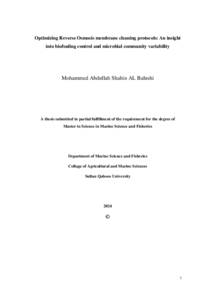وثيقة
Optimizing reverse osmosis membrane cleaning protocols : an insight into biofouling control and microbial community variability
المصدر
Master's thesis
عناوين أخرى
تحسين بروتوكولات تنظيف أغشية التناضح العكسي: نظرة على التحكم في التلوث الحيوي وتغير المجتمعات الميكروبية.
الدولة
Oman
مكان النشر
Muscat
الناشر
Sultan Qaboos University.
ميلادي
2024
اللغة
الأنجليزية
الموضوع
الملخص الإنجليزي
Abstract: The accumulation of organic and inorganic contaminants on the membrane surface, known as fouling, presents a major challenge to desalination plants by decreasing efficiency and raising operating costs. This study investigates the efficacy of three chemical cleaning protocols (A, B, and C) on reverse osmosis (RO) membrane fouling and microbial communities. Using various characterization techniques and microbial analysis, changes in membrane morphology, organic foulant composition, and microbial community were examined in fouled, virgin (unused), and cleaned membranes. Scanning electron microscopy analysis (SEM) revealed dense biofilm layers on fouled membranes, indicating decreased efficiency and potential structural damage. However, all three cleaning protocols effectively removed these biofilms, demonstrating their efficacy. Fourier Transform Infrared Spectroscopy (FTIR) analysis revealed interactions between foulants and membrane surfaces, with aggressive chemical cleaning partially removing foulants, leading to irreversible fouling. Thermogravimetric analysis (TGA) analysis supported these findings, showing no changes in membrane surface properties after cleaning. Microbial characterization revealed significant reductions in microbial counts after cleaning, with cleaning A, showing the most promising results. 16s rRNA amplicon sequencing identified dominant bacterial phyla including Proteobacteria, Firmicutes, and Actinobacteria on fouled membranes, with variations after cleaning. Cleaning A significantly reduced microbial counts and restored microbial community composition to a state resembling virgin membrane. Archaeal communities were also identified, except Cleaning A. Overall, this study enhances understanding of RO membrane cleaning protocols, emphasizing the importance of tailored cleaning strategies for efficient fouling mitigation and microbial management. Cleaning A emerges as the most effective protocol for restoring membrane performance and microbial community composition, laying the groundwork for improved water purification systems.
الملخص العربي
تواجه محطات تحلية المياه تحديات كبيرة نتيجة تراكم الملوثات العضوية وغير العضوية على سطح الأغشية، المعروفة بالتلوث، مما يؤدي إلى تقليل كفاءة العمليات وزيادة تكاليف التشغيل. تركز هذه الدراسة على تقييم فعالية ثلاثة بروتوكولات تنظيف كيميائية (A وB وC) في معالجة التلوث الحيوي والمجتمعات الميكروبية على أغشية التناضح العكسي (RO). باستخدام تقنيات تحليل متعددة، تم فحص التغيرات في مورفولوجيا الأغشية وتكوين الملوثات والمجتمعات الميكروبية في الأغشية الملوثة، وغير المستخدمة، والمُنظّفة. أظهرت نتائج التحليل باستخدام الميكروسكوب الإلكتروني وجود طبقات كثيفة من الأغشية الحيوية على الأغشية الملوثة، مما يشير إلى كفاءة منخفضة وتأثيرات هيكلية محتملة. ومع ذلك، أظهرت بروتوكولات التنظيف الثلاثة فعاليتها في إزالة هذه الأغشية الحيوية، حيث كان البروتوكول A هو الأكثر فعالية. تم الكشف عن وجود مجتمعات بكتيرية رئيسية، بما في ذلك البروتيوباكتيريا، والفيرميكيوت، والأكتينوبيكتيريا، مع تغييرات ملحوظة بعد التنظيف. بالإضافة إلى ذلك، تم تحديد وجود مجتمعات أركية، باستثناء البروتوكول A. تُبرز هذه الدراسة أهمية استراتيجيات التنظيف المصممة خصيصًا لتعزيز الكفاءة وتقليل التلوث الحيوي وإدارة المجتمعات الميكروبية. وقد أظهر البروتوكول A كونه الأكثر فعالية في استعادة أداء الأغشية وتكوين المجتمعات الميكروبية، مما يمهد الطريق لتحسين أنظمة تنقية المياه.
قالب العنصر
الرسائل والأطروحات الجامعية

